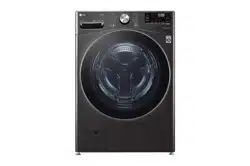Documents: Go to download!
- User Manual - (English, French, Spanish)
OWNER'S MANUAL Washing machine
PRODUCT OVERVIEW
Product Features
- The images in this guide may be different from the actual components and accessories, which are subject to change by the manufacturer without prior notice for product improvement purposes.
- WARNING: For your safety and for extended product life, use only authorized components. The manufacturer is not responsible for product malfunction, property damage or bodily injury caused by the use of separately purchased unauthorized components, parts, or non-LG products.
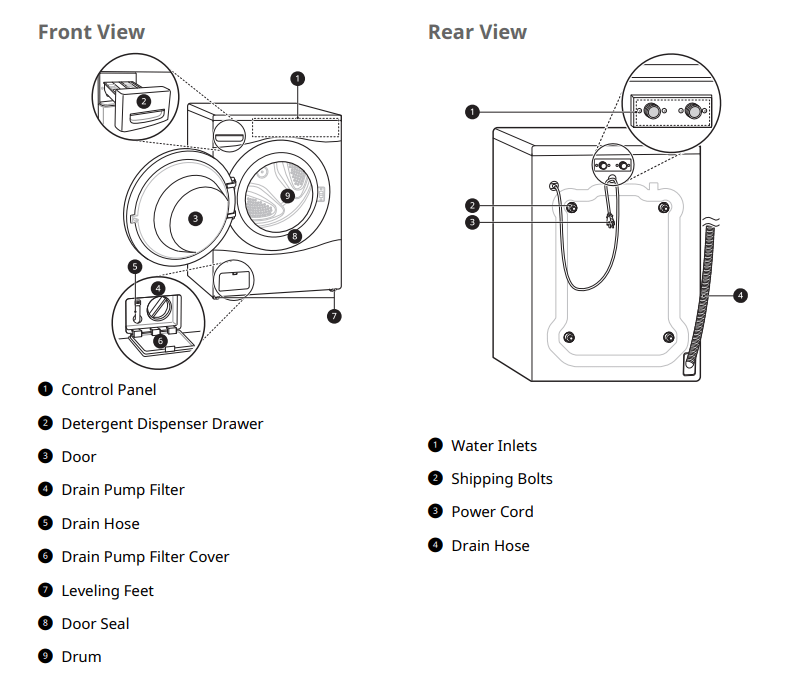
Accessories
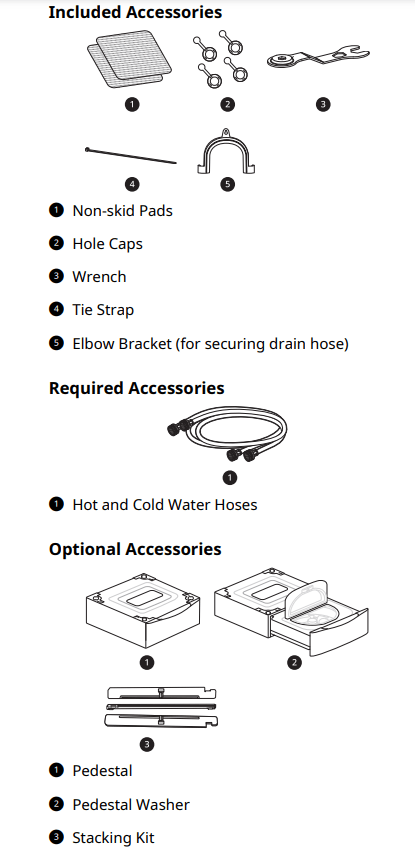
Product Specifications

INSTALLATION
Before Installing
Installation Overview: Please read the following installation instructions first after purchasing this washer or transporting it to another location.

WARNING
- Moving or installation of the appliance requires two or more people. Failure to follow these instructions may result in injury.
- Store and install the appliance where it will not be exposed to temperatures below freezing or exposed to outdoor weather conditions. Failure to follow this warning can cause product or part failure. serious injury, fire,electric shock,or death.
- Properly ground the washer to conform with all governing codes and ordinances. Failure to follow this warning can cause serious injury,fire,electric shock,or death.
- To ensure proper airflow,do not block the large opening on the bottom of the washer with carpeting or other materials.
- Do not remove the ground prong. Do not use an adapter or extension cord. Plug into a grounded 3-prong outlet. Failure to follow this warning can cause serious injury,fire,electric shock. or death.
- Certain internal parts are intentionally not grounded and may present a risk of electric shock only during servicing. Service personnel - Do not contact the following parts while the appliance is energized: pump,valve,motor,control board.
Choosing the Proper Location
Check the following requirements for the install location before installing the washer.
- Allow for sufficient space between the walls and the washer for installation.
- Make sure that the floor is clean, dry and free of dust, dirt, water and oil so the leveling feet cannot slide easily. Leveling feet that can move or slide on the floor can contribute to excess vibration and noise.
- If the floor has too much flex, reinforce it to make it more rigid. If the floor is not solid, it may cause severe vibration and noise.
- If a drain pan must be used, take extra care to follow the instructions provided with the drain pan and make sure the leveling feet are adjusted for firm and even contact with the pan. Use of drain pans and failure to properly level the washer may result in increased vibration and noise during operation.
Power Outlet
- The power outlet must be within 60 inches (1.5 m) of either side of the washer.
- The appliance and outlet must be positioned so that the plug is easily accessible.
- Do not overload the outlet with more than one appliance.
- The outlet must be grounded in accordance with current electrical wiring codes and regulations.
- Use a time-delay fuse or circuit breaker.
- Its the personal responsibility and obligation of the product owner to have a proper outlet installed by qualified service personnel
Flooring
- To minimize noise and vibration, install the washer on a level, solidly constructed floor capable of supporting the washer without flexing or bouncing.
- The washer must be installed on firm flooring to minimize vibration during the spin cycle. Concrete flooring is best, but a wood floor is sufficient, provided it is built to FHA standards.
- The floor under the washer must not slope more than 1 inch (2.5 cm) from front to back or side to side.
- Installing on carpeting and soft tile surfaces is not recommended.
- Never install the washer on a platform or weakly supported structure.
Floor Installation: To ensure sufficient clearance for water inlet hoses, drain hose and airflow, allow minimum clearances of at least 1 inch (2.5 cm) at the sides and 4 inches (10 cm) behind the washer. Be sure to allow for wall, door, or floor moldings that may increase the required clearances.


Stacked or Pedestal Installation
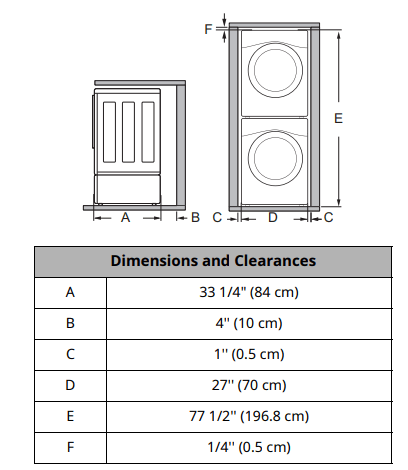
NOTE
- Refer to the instructions packaged with the optional pedestal kit before installing with a pedestal kit.
- Do not use a drip pan with a pedestal or pedestal washer installation as it can block the drawer. Using a drip pan may result in increased vibration and noise during operation.
Unpacking and Removing Shipping Bolts
Unpack all shipping materials from the washer for proper operation and inspect it for shipping damage.
CAUTION: Failure to remove shipping materials can cause excessive noise and vibration
Unpacking Shipping Material * This feature is only available on some models. Lift the washer off the foam base.
- After removing the carton and shipping material, lift the washer off the foam base.
- Make sure the plastic drum support 1* comes off with the base and is not stuck to the bottom of the washer.
- If you must lay the washer down to remove the carton base 2, always protect the side of the washer and lay it carefully on its side. Do not lay the washer on its front or back.
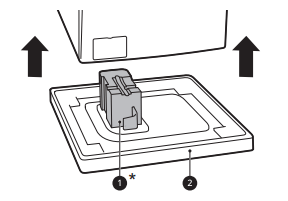
Removing Shipping Material
1 Remove the bolt assemblies.
- Starting with the bottom two shipping bolts 3, use the included wrench to fully loosen all 4 shipping bolts by turning them counterclockwise.
- Remove the bolt assemblies (bolts and retainers) by wiggling them slightly while pulling them out.

2 Install the hole caps.
- Locate the hole caps 4 included in the accessory pack or attached to the back of the washer. Install the caps in the holes left by the bolt assemblies.
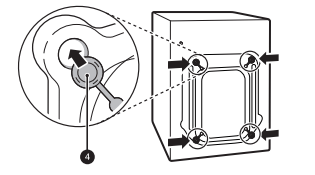
CAUTION: Once removed, save the bolt assemblies for future use. To prevent damage to internal components, do not transport the washer without reinstalling the shipping bolts. Failure to remove shipping bolts and retainers may cause severe vibration and noise, which can lead to permanent damage to the washer.
NOTE: The power cord is secured to the back of the washer with a shipping bolt to help prevent operation with shipping bolts in place.
Connecting the Water Inlet Hoses
To avoid the risk of costly water damage, purchase and install new inlet hoses when installing the washer
WARNING
- Do not overtighten the hoses or cross-thread the hose fittings. Overtightening or cross-threading can damage the valves or couplings, resulting in leaking and property damage.
- Do not reuse old hoses. Use only new hoses when installing the washer. Old hoses could leak or burst causing flooding and property damage. Contact an LG Customer Information Center for assistance in buying hoses.
NOTE
- Periodically check the hoses for cracks, leaks, and wear, and replace the hoses every five years.
- Do not stretch the water hoses intentionally, and make sure that they are not pinched, crushed or kinked by other objects.
- Water supply pressure must be between 20 psi and 120 psi (138 - 827 kPa). If the water supply pressure is more than 120 psi, a pressure reducing valve must be installed.
- Your hot water heater should be set to deliver water at 120–135 °F (48–57 °C) to allow the washer to properly control wash temperatures.
- Do not store or install the washer in a location subject to freezing temperatures. Damage to the water inlet hoses and internal mechanisms of the washer can result. If the washer was exposed to freezing temperatures prior to installation, allow it to stand at room temperature for several hours before use and check for leaks prior to operation.
- Do not use flood-preventing hoses with auto shut off devices. The devices can be tripped during fill and prevent the washer from filling properly.
How to Connect the Water Inlet Hoses
- Check the fifting and seals. Inspect the threaded fifting on each hose and make sure there is a rubber seal 1 in place in both ends of each hose to prevent leaking.

- Connect the water supply hoses. Connect the water supply hoses to the hot and cold water faucets tightly by hand and then tighten another 2/3 turn with pliers. Connect the blue hose to a cold water faucet and the red hose to a hot water faucet.

- Flush out the inlet hoses. After connecting the inlet hoses to the water faucets, turn on the water to flush out foreign substances (dirt, sand or sawdust) in the water lines. Let water drain into a bucket, and check the water temperature to make sure you've connected the hoses to the correct faucets.
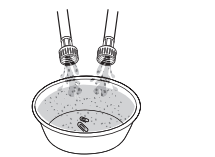
- Attach the water lines to the back of the washer. Attach the hot water line to the hot water inlet on the back of the washer. Attach the cold water line to the cold water inlet on the back of the washer. Tighten the fifting securely. Turn on both faucets.all the way and check for leaks at both ends of the hoses

Connecting the Drain Hose
Connect the drain hose to either a standpipe or laundry tub.
WARNING: The drain hose should always be properly secured. Failure to properly secure the drain hose can result in flooding and property damage.
NOTE
- The drain must be installed in accordance with any applicable local codes and regulations.
- Make sure that the drain hose is not stretched, pinched, crushed, or kinked.
- Do not install the drain hose with the end lower than 29.5 inches (75 cm) or higher than 96 inches (244 cm) above the bottom of the washer or more than 60 inches (152 cm) away from the washer.
- Never create an airtight seal between the hose and the drain with tape or other means. If no air gap is present, water can be siphoned out of the tub resulting in poor wash/rinse performance or clothing damage.
Using a Standpipe to Drain
- Clip the end of the hose into the elbow bracket. Connect the elbow bracket 1 within 4 inches (10 cm) of the end of the drain hose. If the drain hose is extended more than 4 inches (10 cm) beyond the end of the elbow bracket, mold or microorganisms could spread to the inside of the washer.

- Insert the end of the drain hose into the standpipe.

- Use the provided tie strap 2 to secure the drain hose in place..
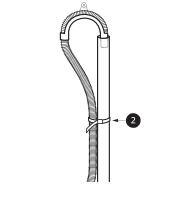
- If the water valves and drain are built into the wall, fasten the drain hose to one of the water hoses with the provided tie strap 3 (ribbed side on inside).
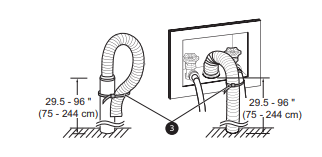
Using the Laundry Tub to Drain
- Clip the end of the hose into the elbow bracket. Connect the elbow bracket 1 within 4 inches (10 cm) of the end of the drain hose. If the drain hose is extended more than 4 inches (10 cm) beyond the end of the elbow bracket, mold or microorganisms could spread to the inside of the washer
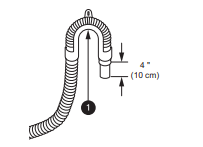
- Hang the end of the drain hose over the side of the laundry tub.
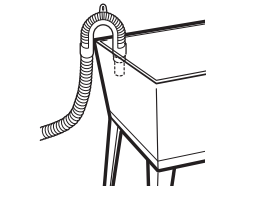
- Use the provided tie strap to secure the drain hose in place.
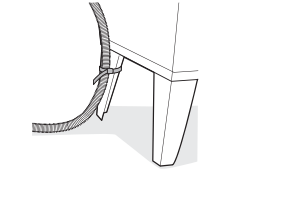
Leveling the Washer
The drum of your new washer spins at very high speeds. To minimize vibration, noise, and unwanted movement, the floor must be a level, solid surface.
CAUTION
- Using the washer without leveling it may cause excess vibration and noise, leading to a washer malfunction.
- Adjust the leveling feet only as far as necessary to level the washer. Extending the leveling feet more than necessary can cause the washer to vibrate.
NOTE: Before installing the washer, make sure that the floor is clean, dry and free of dust, dirt, water and oil so the washer feet cannot slide easily. Feet that move or slide on the floor can contribute to excessive vibration and noise.
- Position the washer in its final location: Take special care not to pinch, strain, or crush the water and drain lines. If you have a carpenter's level 1 , you can place it across the top of the washer. The slope beneath the washer should not exceed 1 inch, and all four leveling feet must rest firmly on the floor
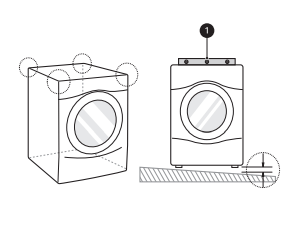
- Adjust the lower leveling feet: Turn all 4 leveling feet in one direction to raise the washer or the other direction to lower it..
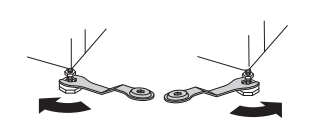
- Check the level again. Push or rock the top edges of the washer gently to make sure the washer does not rock. If the washer rocks, readjust the leveling feet.
- Tighten the locknuts 2. Turn the locknuts counterclockwise and tighten them when the washer is level.

Using Non-Skid Pads: If you install the washer on a slippery surface, it may move because of excessive vibration. Incorrect leveling may cause malfunction through noise and vibration. If this occurs, install the non-skid pads under the leveling feet and adjust the level.
-
Clean the floor to attach the non-skid pads. Use a dry rag to remove and clean foreign objects or moisture. If moisture remains, the non-skid pads may slip.
- Adjust the level after placing the washer in the installation area
- Place the adhesive side 3 of the non-skid pad on the floor. It is most effective to install the non-skid pads under the front leveling feet. If it is hard to place the pads under the front leveling feet, place them under the back leveling feet.
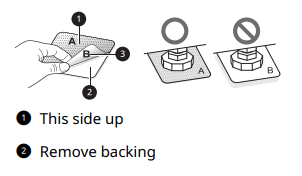
- Recheck the washer’s levelness. Push or rock the top edges of the washer gently to make sure that the washer does not rock. If the washer rocks, level the washer again.
Final Installation Check
Connecting to the Power Supply
Plug the washer into a 120 VAC, 60 Hz grounded 3- prong outlet.
WARNING
- Do not use a worn or damaged power cord or power plug. Replace or repair it immediately. Failure to do so may result in death, fire, electric shock,or malfunction.
- Do not modify the power cord and plug provided with the appliance. Take care not to damage it when installing or moving the washer. Failure to do so may result in death,fire, electric shock, or malfunction.
- Make sure that the washer is grounded.
- Connect this washer to a grounded outlet conforming to the rating prior to use. Failure to do so may result in fire, electric shock, or matfunction.
- Do not damage or cut off the ground prong of the power cord. Doing so may cause death, fire, electric shock, or product malfunction.
- Improper connection of the equipment-grounding conductor can result in risk of electric shock.Check with a qualified electrician or service technician if you are in doubt as to whether the appliance is properly grounded. If it does not fit the outlet, have a proper outlet installed by a qualified electrician
- The appliance and outlet must be positioned so that the plug is easily accessible.
- Do not use adapters or extension cords. Doing so may result in serious injury, fire, electric shock, or death.
- For best performance. plug the washer into its own individual outlet. This helps prevent overloading house wiring circuits which could cause a fire hazard from overheated wires.
- If necessary, use a new. UL-listed 3-prong adapter or 3-wire extension cord with a 3-prong (grounding) plug rated at no less than the branchCircuit. Do not use an extension cord longer than 3 feet. Failure to follow these wamings may result in serious injury, fire, electric shock, or death.
Testing the Washer
Check if the washer is properly installed and run a test cycle.
- Load the washer with 6 pounds of laundry (approximately 6 thick bath towels).
- Press the Power button.
- Press the Rinse+Spin button.
- Press the Start/Pause button. The wash cycle starts.
- Make sure that water is supplied, that the washer does not rock or vibrate excessively, and that it drains well during the spin cycle.
NOTE
- If water leaks during water supply, see Connecting the Water Lines to connect them properly.
- If the washer rocks and vibrates excessively, see Leveling the Washer to level it again.
- If the drain does not work, see Connecting the Drain Hose to install the hose properly
OPERATION
Before Use
WARNING: To reduce the risk of fire, electric shock, or injury to persons, read the SAFETY INSTRUCTIONS before operating this appliance
Operation Overview
1 Sort laundry and load the washer.
- Sort laundry by fabric type, soil level, color and load size, as needed. Open the door and load items into the washer.
- If using single-use detergent packs, place pack into the drum before loading the laundry.
2 Add cleaning products.
- Add the proper amount of HE (High-Efficiency) detergent to the detergent dispenser.
- If desired, add bleach or fabric softener to the appropriate areas of the dispenser drawer.
- Do not place liquid or powdered detergent packs in the dispenser.
3 Turn on the washer.
- Press the Power button to turn on the washer.
4 Select a cycle.
- Turn the cycle selector knob or press the cycle buttons repeatedly until the desired cycle is selected.
- The preset wash temperature, spin speed, soil level and option settings for the selected cycle are shown.
- The Normal cycle must be selected in order to change its default settings.
- Pressing the Start/Pause button without selecting a cycle immediately starts the Normal cycle with the default settings.
5 Adjust settings.
- Default settings for the selected cycle can be changed, if desired, using the cycle modifier and option buttons.
- Not all modifiers and options are available on all cycles. A different chime sounds and the LED does not light up if the selection is not allowed.
6 Begin cycle.
- Press the Start/Pause button to begin the cycle. The door locks, and the washer agitates briefly without water to measure the weight of the load.
- If the Start/Pause button is not pressed within a certain time, the washer shuts off and all settings are lost.
7 End of cycle.
- When the cycle is finished, a melody sounds. Immediately remove the clothing from the washer to reduce wrinkling.
- Check around the door seal when removing the load for small items that may be caught in the seal
Sorting Laundry
CAUTION
- Clothing or articles that are waterproof or water-resistant must be washed in the Waterproof, Bedding, Bulky/Large, or Jumbo Wash cycle only. (Examples include water resistant clothing, mattress covers, outdoor clothes, and plastic mats.) Failure to do so may result in personal injury or damage to the washer, clothes, walls, floor, and surrounding objects due to abnormal vibration.
- Remove the stuffing from pillows and cushions before washing the covers. Failure to do so can cause excessive vibration, resulting in damage to the washer, clothes, nearby objects, walls, and floor.
Grouping Similar Items
- For the best washing results, and to reduce the possibility of damage to clothing, sort clothing into loads made up of similar items.
- Mixing different fabric types and/or soil levels can result in poor wash performance, color transfer, discoloration, fabric damage or linting. Fabrics should be sorted into groups as described below.
- Colors: Sort articles by color. Wash dark clothes separately from light colors or whites. Mixing dark clothes with light clothes can result in dye transfer or discoloration of the lighter clothes.
- Soil Level: Wash heavily soiled clothing together. Washing lightly soiled clothing in the same load with heavily soiled clothing could result in poor wash performance for the lightly soiled clothing.
- Fabric Type: Delicate articles should not be mixed with heavy or sturdy fabric types. Washing heavy fabrics with delicates can result in poor wash performance for the heavy fabrics and possible damage to the delicates.
- Lint Type: Some fabrics attract and bind lint to them while others give off lint in the laundry process. Avoid mixing these lint collectors and lint producers in the same load. Mixing these fabrics will result in pilling and linting on the lint collectors. (For example, lint collector - knit sweater; lint producer - terry cloth towels.)
Loading the Washer
CAUTION: Clothing or articles that are waterproof or waterresistant must be washed in the Waterproof, Bedding, Bulky/Large, or Jumbo Wash cycle only. (Examples include water resistant clothing, mattress covers, outdoor clothes, and plastic mats.) Failure to do so may result in personal injury or damage to the washer, clothes, walls, floor, and surrounding objects due to abnormal
General Tips
- Check and empty pockets. Paper clips, coins, matches, etc.can damage clothing and the washer.
- Close zippers and hooks, and tie drawstrings to prevent snagging or tangling of clothes.
- Pretreat heavily stained areas for best results
- Brush off heavy soil, dust, and hair from items before washing. Excess dirt or sand can abrade other fabrics and lead to poor wash performance.
- For best performance, load clothes as shown.

- Do not press down on items while stacking them in the drum.
- Load clothes loosely, and do not overfill the drum. Clothes need room to circulate in order to get clean.
- Combine large and small items in the drum. Load large items first. Large items should not be more than half of total load.
- The washer can be fully loaded, but the drum should not be tightly packed with items. The door of the washer must close easily.
- The washer will not fill or operate with the door open.
Bulky Items
- Wash thick, bulky items individually. Heavy blankets, comforters, bed spreads, or pet beds can get tangled or cause an unbalanced load if combined with other items.
Small Items
- Do not wash a single small item. Add enough similar items to the load to prevent an out-ofbalance load.
- Wash small, light items in a mesh bag. Small items can get caught in the impeller at the bottom of the drum, and brassiere hooks can snag on other clothing or the drum.
Adding Cleaning Products
About Detergent: Use This washer is designed for use with only HE (HighEfficiency) detergents.

- HE detergents produce fewer suds, dissolve more efficiently to improve washing and rinsing performance, and help to keep the interior of the washer clean. Using detergent that is not HE may cause oversudsing and unsatisfactory performance which could result in error codes, cycle failure, and washer damage.
- Detergents designated as HE-compatible may not provide optimal results.
- For proper wash performance, always measure detergent using the measuring device provided by the detergent manufacturer. For an average load, use less than half of the recommended maximum. Use less detergent for soft water, light soil, or smaller loads.
- Use extra care when measuring 2X and 3X concentrated detergents because even a small amount of extra detergent can lead to problems.
- Never use more than the maximum amount of detergent recommended by the manufacturer. Using too much detergent can lead to oversudsing, poor rinsing, detergent buildup in clothing, and residue buildup that can contribute to odors in the washer.
- Do not use more than one single-use detergent pack in the washer. Using too much detergent may cause oversudsing and unsatisfactory performance. Reduce detergent amount or add an extra rinse if detergent residue is left on fabrics. To add an extra rinse, select the Extra Rinse option.
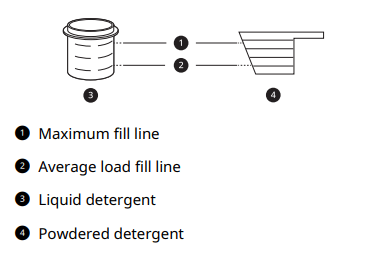
Single-Use Detergent Packs: Place liquid or powdered detergent packs in the drum before loading laundry. Do not place detergent packs in the dispenser.
Using the Dispenser: To add cleaning products to the automatic dispenser:
1 Open the dispenser drawer.
2 Load the laundry products into the appropriate compartments.
- Follow the manufacturer’s recommendations when adding cleaning products.
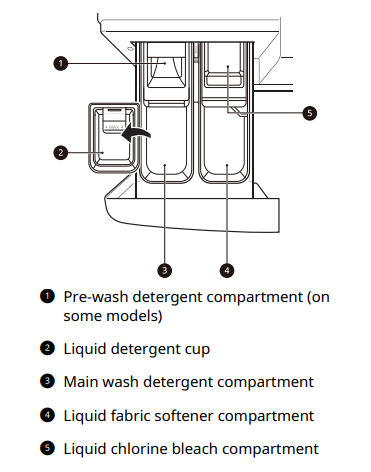
3 Gently close the detergent dispenser drawer before starting the cycle.
- Slamming the drawer closed may result in the detergent overflowing into another compartment or dispensing into the drum earlier than programmed.
- Be careful not to get a hand caught in the drawer while closing.
- It is normal for a small amount of water to remain in the dispenser compartments at the end of the cycle.
Pre-wash Detergent Compartmen:t Add liquid or powdered detergent to this compartment when using the Pre-wash option. Always use HE (High-Efficiency) detergent with your washer.
- When using the Pre-wash option, liquid detergent for the main wash needs to be loaded in the liquid detergent cup accessory in the main wash dispenser (where applicable), to prevent it from being dispensed with the pre-wash detergent.
- The amount of detergent added for the Prewash option is 1/2 the amount recommended for the main wash cycle. For example, if the main wash cycle requires one measure of detergent, add 1/2 measure for the Pre-wash option.
Main Wash Detergent Compartment: This compartment holds laundry detergent for the main wash cycle. Either powdered or liquid detergent may be used in this compartment.
- The detergent is added to the load at the beginning of the cycle. Always use HE (HighEfficiency) detergent with your washer.
- Do not exceed the maximum fill line. Using too much detergent can result in detergent buildup in clothing and the washer.
- Liquid or powdered color-safe bleach may be added to the main wash compartment with detergent of the same type. Do not mix liquids and powders
- If the dispenser has a liquid detergent cup and insert: - Make sure they are in place when using liquid detergent. - Make sure to remove them when using powdered detergent. Powdered detergent will not dispense with the liquid detergent cup and insert in place.
- If you use a detergent that does not dissolve easily or a detergent with high viscosity, it will leave a residue and clog the dispenser.
Liquid Bleach Compartment: This compartment holds liquid bleach, which is dispensed automatically at the proper time during the wash cycle. The dispenser is activated twice to ensure complete dispensing of the bleach. Any liquid remaining in the dispenser at the end of the cycle is water, not bleach.
Fabric Softener Compartment: This compartment holds liquid fabric softener, which is automatically dispensed during the final rinse cycle. Either powdered or liquid fabric softener may be used.
- Do not exceed the maximum fill line. Using too much fabric softener may stain clothes or cause buildup on fabrics or in the washer.
- Dilute concentrated fabric softeners with warm water.
- Never pour fabric softener directly onto the load or into the drum.
Control Panel
Control Panel Features

1 Power On/Off Button
- Press this button to turn the washer on or off.
- Pressing this button during a cycle will cancel that cycle and any load settings will be lost.
- The door will unlock after a brief pause
2 Cycle Selector Knob
- Turn this knob to select the desired cycle.
- Once the desired cycle has been selected, the standard presets will appear in the display. These settings can be adjusted using the Cycle Modifier buttons at any time before starting the cycle.
3 Start/Pause Button
- Press this button to start the selected cycle.
- If the washer is running, use this button to pause the cycle without losing the current settings
4 Cycle Modifier Buttons
- Use these buttons to adjust the wash temperature, spin speed and soil level settings for the selected cycle.
- The current settings are shown in the display.
- Press the button for that option to select other settings.
5 Time and Status Display
6 Option and Extra Function Buttons
- These buttons allow you to select additional cycle options. Certain buttons also allow you to activate special functions by pressing and holding the button for 3 seconds.
Time and Status Display
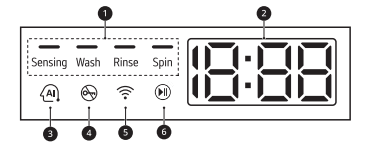
1 Cycle Status Indicators
- These LEDs will blink when a cycle is selected to indicate which stages will run.
- When a cycle is running, the LED for the active stage will blink, and the LEDs for the remaining stages will remain steady. Once a stage is complete, the LED will turn off. If a cycle is paused, the active stage LED will stop blinking.
2 Estimated Time Remaining
- When a cycle is selected, the default time for that cycle is displayed. This time will change as modifiers or options are selected.
- If the display shows ---, then the time will be displayed after the load sensing has detected the load size.
- The time shown is only an estimate. This time is based on normal operating conditions. Several external factors (load size, room temperature, incoming water temperature, etc.) can affect the actual time.
3 AI DD Indicator
- AI DD provides the appropriate drum rotation actions after load sensing is completed.
- This indicator lights up when:
- the Normal cycle is selected and operated, except for when the Heavy soil level is selected.
- the Bright WhitesTM and Rinse+Spin cycles are selected and operated with any cycle options
4 Door Lock Indicator
- This indicator lights up when the cycle starts and the door is locked.
- The indicator light stays on until the cycle is paused, stopped or has finished.
5 Wi-Fi Indicator
- This indicator is lit when the product is connected to a home Wi-Fi network.
6 Remote Start Indicator
- This indicator lights up when the Remote Start feature is activated.
SMART FUNCTIONS
Using LG ThinQ Application
The LG ThinQ application allows you to communicate with the appliance using a smartphone.
LG ThinQ Application Features
- Remote Start - It allows you to control the appliance remotely from the LG ThinQ application.
- Downloaded - It allows you to download new and specialized cycles that are not included in the standard cycles on the appliance.
- Tub Clean Coach - This function shows how many cycles remain before it is time to run the Tub Clean cycle.
- Energy Monitoring - This feature keeps track of the washer’s power consumption affected by selected washing cycles and options.
- Smart DiagnosisTM - This function provides useful information for diagnosing and solving issues with the appliance based on the pattern of use.
- Push Alerts - When the cycle is complete or the appliance has problems, you will receive a push message.
- Settings - Allows you to set various options on the appliance and in the application.
Before Using LG ThinQ Application
- Check the distance between the appliance and the wireless router (Wi-Fi network). If the distance between the appliance and the wireless router is too far, the signal strength becomes weak. It may take a long time to register or installation may fail.
- Turn off the Mobile data or Cellular Data on your smartphone.
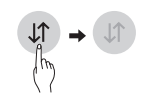
- Connect your smartphone to the wireless router.
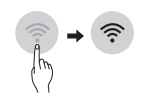
NOTE
- To verify the Wi-Fi connection, check that Wi-Fi
 icon on the control panel is lit.
icon on the control panel is lit. - The appliance supports 2.4 GHz Wi-Fi networks only. To check your network frequency, contact your Internet service provider or refer to your wireless router manual.
- LG ThinQ is not responsible for any network connection problems or any faults, malfunctions, or errors caused by network connection.
- The surrounding wireless environment can make the wireless network service run slowly
- If the appliance is having trouble connecting to the Wi-Fi network, it may be too far from the router. Purchase a Wi-Fi repeater (range extender) to improve the Wi-Fi signal strength.
- The network connection may not work properly depending on the Internet service provider.
- The Wi-Fi connection may not connect or may be interrupted because of the home network environment.
- If the appliance cannot be registered due to problems with the wireless signal transmission, unplug the appliance and wait about a minute before trying again.
- If the firewall on your wireless router is enabled, disable the firewall or add an exception to it.
- The wireless network name (SSID) should be a combination of English letters and numbers. (Do not use special characters.)
- Smartphone user interface (UI) may vary depending on the mobile operating system (OS) and the manufacturer.
- If the security protocol of the router is set to WEP, network setup may fail. Change the security protocol (WPA2 is recommended), and register the product again.
Installing the LG ThinQ Application
- Search for the LG ThinQ application from the Google Play Store or Apple App Store on a smart phone. Follow instructions to download and install the application.
Using the Appliance Remotely
Remote Start: Use a smartphone to control your appliance remotely. You can also monitor your cycle operation so you know how much time is left in the cycle.
Using Remote Start
- Put the laundry in the drum and add detergent to the detergent dispenser drawer. If desired, add bleach or fabric softener to the appropriate areas of the dispenser.
- Press the Power button.
- Press and hold the Remote Start button for 3 seconds to enable the remote control function.
- Start a cycle from the LG ThinQ application on your smartphone.
Disabling Remote Start Manually: When the function is activated, press and hold the Remote Start button for 3 seconds.
Download Cycle
- You can download new and specialized cycles that are not included in the standard cycles on the appliance.
- Appliances that have been successfully connected can download a variety of specialty cycles specific to the appliance.
- Once cycle download is completed in the appliance, the product keeps the downloaded cycle until a new cycle is downloaded.
Smart Diagnosis™ Function
- This feature is only available on models with the
 or
or  logo.
logo. - Use this feature to help you diagnose and solve problems with your appliance.
NOTE
- For reasons not attributable to LGE’s negligence, the service may not operate due to external factors such as, but not limited to, Wi-Fi unavailability, Wi-Fi disconnection, local app store policy, or app unavailability.
- The feature may be subject to change without prior notice and may have a different form depending on where you are located.
Using LG ThinQ to Diagnose Issues: If you experience a problem with your Wi-Fi equipped appliance, it can transmit troubleshooting data to a smartphone using the LG ThinQ application.
- Launch the LG ThinQ application and select the Smart DiagnosisTM feature in the menu. Follow the instructions provided in the LG ThinQ application.
Using Audible Diagnosis to Diagnose Issues: Follow the instructions below to use the audible diagnosis method.
- Launch the LG ThinQ application and select the Smart DiagnosisTM feature in the menu. Follow the instructions for audible diagnosis provided in the LG ThinQ application
1. Press the Power button to turn on the appliance.
- Do not press any other buttons.
2 Place the mouthpiece of your smartphone close to the  or
or  logo.
logo.

3 Press and hold the Temp. button for 3 seconds or until the audible tones start. Hold the smartphone mouthpiece to the logo until the data transfer is complete.
- Keep the smartphone in place until the data transfer has finished. Time remaining for data transfer is displayed.
4 After the data transfer is complete, the diagnosis will be displayed in the application.
MAINTENANCE
WARNING:
- To reduce the risk of fire, electric shock, or injury to persons, read this entire owner's manual, including the Important Safety Instructions, before operating this washer.
- Unplug the washer before cleaning to avoid the risk of electric shock. Failure to follow this warning can cause senous injury, fire, electric shock, or death.
- Do not use volatile substances (benzene, paint thinner, alcohol, acetone, etc.), abrasive cleaners, or detergents with strong chemical components when cleaning the washer. Doing so may cause discoloration or damage to the machine, or may cause a fire
- Certain internal parts are intentionally not grounded and may present a risk of electric shock only during servicing. Service personnel - Do not contact the following parts while the appliance is energized: pump, valve, motor, control board.
Regular Cleaning
Care After Wash: After the cycle is finished, wipe the door and the inside of the door seal to remove any moisture.
- Wipe the body of the washer with a dry cloth to remove any moisture.
- Leave the door open to dry the drum interior.
WARNING: Make sure children and pets do not climb into the drum. Engage the Control Lock feature if needed to prevent children from accidentally starting a wash cycle.
Cleaning the Exterior: Proper care of your washer can extend its life.
- Door: Wash with a damp cloth on the outside and inside and then dry with a soft cloth.
- Exterior:
- Immediately wipe off any spills.
- Wipe with a damp cloth.
- Do not touch the surface or the display with sharp objects.
Periodic Maintenance
- Use a towel or soft cloth to wipe around the washer door opening and door glass.
- Always remove items from the washer as soon as the cycle is complete. Leaving damp items in the washer can cause wrinkling, color transfer, and odor.
Cleaning the Drum: Over time, residue may build up in the drum, leading to mildew or a musty odor. Run the Tub Clean cycle monthly to remove residue and prevent odor. Run the cycle more often under heavy use conditions or if odor is already present
NOTE
- Make sure to run the Tub Clean cycle only when the drum is empty. Never load laundry while using this cycle. The laundry may be damaged or contaminated with cleaning products.
- Run the cycle more often under heavy use conditions or if odor is already present.
- If mildew or musty smell already exists, run this cycle once a week for three consecutive weeks.
1. Remove any clothing from the drum.
2. Add cleaning agents
Cleaner
- Drum cleaner
- Lime scale remover
- Add to main detergent compartment of detergent dispenser
- Liquid chlorine bleach: Add to bleach compartment of detergent dispenser
- Powdered cleaner: Pull out liquid detergent cup before adding to main detergent compartment
- Cleaning tablets: Place directly into washer drum
For other drum cleaning products, follow the cleaner manufacturer’s instructions and recommendations.
Do not exceed the maxium fill line when adding bleach or powdered cleaners. Powdered detergent may remain in the drum after cleaning.
3. Close the door and press the Power button
4 Select the Tub Clean cycle then press the Start/Pause button to begin the cycle.
5 After the cycle ends, open the door and allow the drum interior to dry completely
WARNING: Make sure children and pets do not climb into the drum. Engage the Control Lock feature if needed to prevent children from accidentally starting a wash cycle.
NOTE: If you use a descaler or drum cleaner during the Tub Clean cycle, use the Rinse+Spin option to rinse the washer drum before running your next wash cycle.
Automatic Alert for Tub Clean: When the power is on and the  message blinks on the display, it means the washer drum needs cleaning. Use the Tub Clean cycle to clean the washer drum. The frequency of the automatic alert's appearance depends on how often the washer is used. However the message will generally appear every one to two months.
message blinks on the display, it means the washer drum needs cleaning. Use the Tub Clean cycle to clean the washer drum. The frequency of the automatic alert's appearance depends on how often the washer is used. However the message will generally appear every one to two months.
Removing Mineral Buildup
In areas with hard water, mineral scale can form on internal components of the washer. Periodically clean the mineral buildup on the internal components to extend the lifespan of the washer.
- Use of a water softener is recommended in areas with hard water. Use a descaler to remove visble mineral buildup on the washer drum.
- After descaling, always run the Tub Clean cycle before washing clothing.
- Mineral scale and other spots may be removed from the stainless steel drum using a soft cloth soaked in stainless steel cleaner.
- Do not use steel wool or abrasive cleaners
Leaving the Door Open: After you finish using the washer, leave the door open overnight to allow air to circulate and dry the drum. This helps prevent odors
Cleaning the Detergent Dispenser Drawer
Leaving detergent in the detergent dispenser drawer for an extended period of time or using the washer for a long period of time may cause the build-up of residue in the detergent dispenser drawer. Remove and clean the detergent dispenser drawer once or twice a month.
WARNING: Do not spray water inside the washer. Doing so may cause fire or electric shock.
1 Turn off the washer, and unplug the power cord.
2 Pull the drawer straight out until it stops.
3 Press down hard on the disengage button 1 and pull the drawer completely out.

4 Remove the inserts from the drawer.
5 Clean the inserts and drawer with warm water.
- Use a soft cloth or brush to clean and to remove any residue.
- Do not use soap when cleaning the drawer and inserts.
6 Wipe off any moisture with a dry towel or cloth after cleaning.
7 To clean the drawer opening, use a small, non-metal brush to clean the recess. Remove all residue from the upper and lower parts of the recess.
8 Replace the drawer.
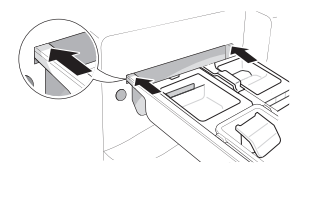
Cleaning the Door Seal
Clean the door seal once a month to prevent build-up of dirt.
CAUTION: Cleaning the door seal with undiluted bleach may cause malfunction of the door seal and washer parts. You must add water to the bleach before using it.
- Wear rubber gloves and protective goggles.
- Dilute 3/4 cup (177 ml) of liquid chlorine bleach in 1 gallon (3.8 L) of water.
- Wipe around the door seal. Soak a sponge or a soft cloth in this diluted solution and wipe all around the door seal.
- Wipe dry. After cleaning, wipe up any moisture with a dry towel or cloth.
- Leave the door open to allow the door seal to dry completely
Cleaning the Water Inlet Filters
If the washer does not fill property, an error message will show on the display. The inlet valve filter screens could be plugged by hard water scale, sediment in the water supply, or other debris
WARNING
- The inlet screens protect the delicate parts of the inlet valve from being damaged by particles that could enter the valves with the water supply. Operating the washer with these filters removed could cause a valve to open continuously, resulting in flooding and/or property damage.
CAUTION
- Do not use the washer without the inlet filters. Doing so will cause leaks and malfunction.
- If you use the washer in an area with hard water, the inlet filter may clog due to lime buildup and require more frequent cleaning.
1 Turn off the washer, and unplug the power cord.
2 Turn off hot and cold water faucets.
3 Unscrew the hot and cold water hoses from the back of the washer.
4 Remove the filters from the water valves carefully.
- Use pliers to pull out the filters from the water valves.
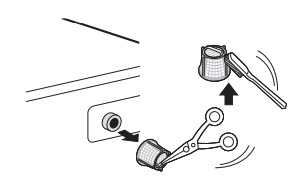
5 Remove foreign objects and soak the filters in white vinegar or a lime scale remover.
- If using a lime scale remover, follow the manufacturer’s instructions. Be careful not to damage the filters while cleaning them.
6 Rinse filters thoroughly and press them back into place.
7 Flush then reattach the water hoses.
- Before reattaching the water inlet hoses, flush them by running several gallons of water through them into a bucket or drain, preferably with the faucets wide open for maximum flow.
NOTE: An  message may blink on the display when the water pressure is weak or an inlet filter is clogged with dirt. Clean the inlet filter.
message may blink on the display when the water pressure is weak or an inlet filter is clogged with dirt. Clean the inlet filter.
Cleaning the Drain Pump Filter
The washer fails to drain if the drain pump filter is clogged. Periodically clean the drain filter to prevent Filter clogging with foreign objects.
WARNING
- Opening the drain filter will result in water overflowing if there is water in the drum. Use a bucket if the drum is not completely drained before you open the drain filter.
- Using the washer without the drain filter or with an incorrectly assembled drain filter may cause leaks or malfunction of the washer.
1 Turn off the washer, and unplug the power cord.
2 Open the drain pump filter cover.
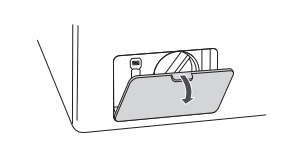
3 Drain any remaining water. Unclip the drain hose and remove the plug from the drain hose to drain the remaining water.
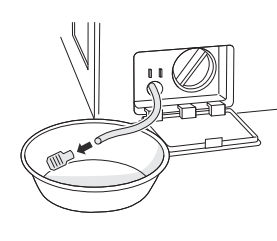
4 Remove the pump filter. Twist the pump filter counterclockwise to remove
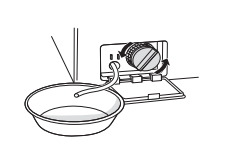
5 Clean the pump filter and opening
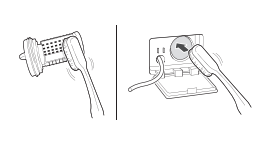
6 Reassemble the plug onto the drain hose and reclip the drain hose.
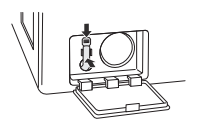
7 Insert the drain pump filter

8 Close the drain pump filter cover.
An  message may blink on the display when the drain pump filter is clogged with dirt. Clean the drain pump filter.
message may blink on the display when the drain pump filter is clogged with dirt. Clean the drain pump filter.
Care in Cold Climates
Storing the Washer: If the washer will not be used for an extended period of time and is in an area that could be exposed to freezing temperatures, perform the following steps to protect the washer from damage.
- Turn off the washer, and unplug the power cord.
- Turn off the water faucets.
- Disconnect the hoses from the water supply. Drain any water from the hoses.

- Plug the power cord into a properly grounded electrical outlet.
- Add 1 gallon of nontoxic recreational vehicle (RV) antifreeze to the empty drum and close the door. Never use automotive antifreeze.
- Turn on the washer and press the Spin button.
- Press the Start/Pause button to start the drain pump for 1 minute. This will expel some of the antifreeze, leaving enough to protect the washer from damage.
- Turn off the washer and unplug the power cord.
- Dry the drum interior with a soft cloth, and close the door.
- Store the washer in an upright position.
- Remove the inserts from the dispenser. Drain any water in the compartments and let them dry.
- To remove the antifreeze from the washer after storage, run the Rinse+Spin cycle using detergent. Do not add laundry to this cycle
When the Water Inlet Hoses Are Frozen
- Turn off the washer, and unplug the power cord.
- Turn off the faucets connected to the water inlet hoses.
- Pour hot water on the frozen faucets to thaw the water inlet hoses and remove the water inlet hoses.
- Immerse the water inlet hoses in hot water to thaw them.
- Reconnect the water inlet hoses to the water inlets of the washer and to the faucets. See Connecting the Water Inlet Hoses for details.
- Turn on the faucets.
- Press the Power button to turn on the washer.
- Press the Spin button to operate spin only cycle for draining and spinning.
- Press the Start/Pause button
When the Drain Hose is Frozen
- Pour hot water in the washer drum and close the door.
- Wait for 1 - 2 hours.
- Press the Power button.
- Press the Spin button to operate spin only cycle for draining and spinning.
- Press the Start/Pause button to make sure the water drains.
TROUBLESHOOTING
Before Calling for Service
The washer is equipped with an automatic error-monitoring system to detect and diagnose problems at an early stage. If the washer does not function properly or does not function at all, check the following before you call for service.
FAQs
1. Why does my washer make loud banging noises while itis filling with water?
- This is actually a problem with the plumbing in your home. When the water valve in the washer shuts off. it can cause pipes in your home to move, resulting in a loud banging noise. This effect. called water hammer, can be reduced by installing an item called a water hammer arrestor. Add-on arrestors can be purchased through your local hardware or home improvement store.
2. Why is there so little water in my washer? How can it clean the clothes?
- HE (High-Efficiency) washers are designed to properly wash your laundry while using a minimum amount of water and energy. Because the water volume is low, the small amount of detergent used is more concentrated in the water, resulting in excellent cleaning performance.
3. When | press a button. why does my washer beep and then nothing happens?
- The Control Lock feature is turned on. To turn off Control Lock, turn the washer on, then press and hold the button that has "*Control Lock" on or under it for 3 seconds.
4. Where should | pour my powdered laundry products when doing my laundry?
- If you are using powdered laundry detergent, load it in the main detergent dispenser after removing the liquid detergent insert. Powdered laundry agents or powdered color safe bleach should be put directly into the drum. These products can be put in the empty drum before loading or on top of the laundry after loading the washer.
Error Messages
1.  INLET ERROR
INLET ERROR
- Water supply faucets are not fully open.
- Make sure that the water faucets are fully open.
- Water inlet hoses are kinked, pinched, or crushed.
- Make sure that the hoses are not kinked, pinched or crushed behind or under the washer. Be careful when moving the washer during cleaning or maintenance.
- Water inlet filters are clogged.
- Clean the inlet filters. See MAINTENANCE.
- Water supply pressure to faucet or house is too low.
- Check another faucet in the house to make sure that household water pressure is adequate and flow is not restricted.
- Disconnect the water inlet hoses from the washer and run a few gallons of water through the hoses to flush out any dirt.
- If flow is too low, contact a plumber to have the water supply lines repaired.
- Water supply connected with leak-limiting hoses.
- The use of hoses designed to limit leaks is not recommended. Leak limiting hoses can trip falsely and prevent the washer from filling.
2.  UNBALANCE ERROR
UNBALANCE ERROR
- The load is too small.
- Add additional items to allow the washer to balance the load.
- Heavy articles are mixed with lighter items.
- Always try to wash articles of somewhat similar weight to allow the washer to evenly distribute the weight of the load for spinning.
- The load is out of balance.
- Manually redistribute the load if articles have become tangled, preventing the automatic rebalancing from working properly
3.  DOOR OPEN ERROR
DOOR OPEN ERROR
- The door is not secured.
- Close and secure the door. If the message keeps appearing, unplug the power cord and call for service.
4.  WATER OUTLET ERROR
WATER OUTLET ERROR
- Drain hose is kinked, pinched, or clogged.
- Make sure that the drain hose is free of clogs or kinks and is not pinched behind or under the washer.
- The end of the drain hose is more than 96 inches (2.4 m) above the bottom of the washer.
- Move the end of the drain hose so that it is lower than 96 inches (2.4 m).
5.  TEMPERATURE SENSOR ERROR
TEMPERATURE SENSOR ERROR
- Control error.
- Unplug the washer and wait 60 minutes. Reconnect power and try again.
- If the error code is still displayed, call for service
6.  OVERFLOW ERROR
OVERFLOW ERROR
- Water level is too high due to a faulty water valve.
- Close the water faucets, unplug the washer, and call for service
7.  PRESSURE SENSOR ERROR
PRESSURE SENSOR ERROR
- The water level sensor is not working correctly.
- Close the water faucets, unplug the washer, and call for service.
8.  MOTOR LOCKED ERROR
MOTOR LOCKED ERROR
- A motor error has occurred.
- Allow the washer to stand for 30 minutes and then restart the cycle.
- If the error code is still displayed, call for service.
9.  OVERSUDSING DETECTION
OVERSUDSING DETECTION
- Oversudsing of detergent
- Do not add more than the manufacturer’s recommended amount of detergent.
- To remove suds, turn the washer off then back on, then run the Rinse+Spin cycle.
- If too many suds are detected during spinning, the washer stops to help prevent leaking.
10.  WATER LEVEL SENSOR ERROR
WATER LEVEL SENSOR ERROR
- Water level is too low or high compared to the load.
- Unplug the washer and wait for 60 minutes. Reconnect power and try again.
- If the error code is still displayed, call for service
11.  FROZEN ERROR
FROZEN ERROR
- Inlet hose, drain hose or drain pump is frozen.
- See Care in Cold Climates.
12.  CONTROL LOCK FUNCTION
CONTROL LOCK FUNCTION
- The Control Lock function is on to prevent anyone from changing cycles or operating the washer.
- Turn off the Control Lock function in the control panel. See Control Lock under Options and Extra Functions
13.  TUB CLEAN ALARM
TUB CLEAN ALARM
- It is time to run the Tub Clean cycle.
- This is not an error code. It indicates that the Tub Clean cycle is running or needs to be run to clean the washer drum.
14.  VIBRATION SENSOR ERROR
VIBRATION SENSOR ERROR
- Vibration sensor malfunctions.
- Call for service.
Noises
1. Clicking
- Door lock sounds when the door locks or unlocks.
- Normal operation
2. Spraying or Hissing
- Water spraying or circulating during the cycle.
- Normal Operation
3. Humming or Gurgling
- Drain pump is pumping water from the washer at times during a cycle.
- Normal Operation
4. Water sloshing
- A liquid in the balance ring around the wash basket helps the basket spin smoothly.
- Normal Operation
5. Water being added after the washer has already begun to operate
- The washer adapts to the load size and type to add more water to the cycle as needed.
- Normal Operation
- The wash load may be unbalanced. If the washer senses that the load is unbalanced, it will stop and refill to redistribute the load.
- Normal Operation
- The washer may be diluting laundry additives to add to the wash load
- Normal Operation
6. Rattling and clanking noise
- Foreign objects, such as keys, coins, or safety pins may be in drum or pump.
- Stop washer, check drum and drain filter for foreign objects.
- If noise continues after washer is restarted, call for service.
7. Thumping sound
- Heavy wash loads may produce a thumping sound.
- This is normal. If sound continues, washer is probably out of balance. Stop and redistribute wash load.
- Wash load may be out of balance.
- Pause the cycle and redistribute the load.
8. Vibrating noise
- Packaging materials were not removed.
- See the Unpacking and Removing Shipping Bolts information in the Installation section.
- Wash load may be unevenly distributed in the drum.
- Pause the cycle and redistribute the load.
- Not all leveling feet are resting
- See Leveling the Washer in the Installation section.
- Floor not rigid enough.
- Make sure that the floor is solid and does not flex. See the Flooring in the Installaion section.
9. Squeaking noise
- Packaging materials were not removed.
- See the Unpacking and Removing Shipping Bolts information in the Installation section.
10. Banging noise when washer is filling with water (Water Hammer)
- Plumbing in the home moves or flexes when the water valves in the washer shut off.
- Water hammer is not caused by a defect in the washer. Install water hammer arrestors (purchased separately at hardware or home improvement store) betwwen the fill hose and the washer for best results.
- Household water supply pressure is very high.
- Adjust household water supply regulator to a lower pressure or contact a plumber.
Operation
1. Water leaking
- Hoses are not connected correctly.
- Check hoses and connectors for leaks, cracks, and splits.
- Check and tighten hose connections.
- House drain pipes are clogged.
- The washer pumps out water very rapidly. Check for water backing up out of the drain pipe during drain. If water is seen coming out of the drain, check for proper drain hose installation and check for restrictions in the drain. Contact a plumber to repair drain pipe
- Drain hose has come out of drain or is not inserted far enough.
- Tie drain hose to inlet hose or standpipe to prevent it from coming out during drain.
- For smaller drain pipes, insert the drain hose into the pipe as the drain hóe flange. Forl arger drain pipes, insert the drain hose into the pipe 1 - 2 inches past the flange
- Oversudsing of detergent.
- Oversudsing may create leaks, and may be caused by the type and amount of detergentused. High - efficiency detergent is the only detergent recommended. The normal amount of detergent to use is 1/4 to 1/2 of the maximum amount recommended by the detergent manufacturer.
- Always reduce the amount of detergent if the load is small or lightly soiled, or if the water is very soft.
- Never use more than the maximum amount recommended by the detergent manufacturer.
2. Excessive sudsing
- Too much detergent or incorrect detergent.
- HE detergents are formulated specifically for HE (High-Efficiency) washers and contain suds reducing agents. Only use detergent with the HE (High-Efficiency) logo.
- For detergent quantities refer to Detergent Use in OPERATION. If sudsing or detergent residue continues to be an issue, add an extra rinse.
3. Washer will not turn on
- Power cord is not properly plugged in.
- Make sure that the plug is plugged securely into a grounded, 3-prong, 120-VAC, 60 Hz outlet.
- House fuse is blown, circuit breaker has tripped, or power outage has occurred.
- Reset circuit breaker or replace fuse. Do not increase fuse capacity. If the problem is a circuit overload, have it corrected by a qualified election
4. Wash cycle time is longer than usual
- The washer automatically adjusts the wash time for the amount of laundry, water pressure and other operating conditions.
- This is normal. The washer adjusts cycle time automatically to provide optimal results for the selected cycle. The time remaining shown in the display is only an estimate. Actual time may vary
5. Incomplete or no dispensing of detergent
- Detergent compartments clogged from incorrect filling.
- Make sure that detergent and additives are put into the correct dispenser compartments.
- For all detergent types, always make sure that the dispenser drawer is fully closed before the start of the cycle.
- Too much detergent used.
- Make sure that the suggested amount of detergent is used according to the manufacturer’s recommendations. You may also dilute the detergent with water to the maximum fill line on the compartment to avoid clogging. Use only HE (High-Efficiency) detergent.
- NOTE: Always use as little detergent as possible. HE (High-Efficiency) washers need very little detergent to achieve optimum results. Using too much detergent will cause poor wash and rinse performance and may contribute to odors in the washer.
- Insufficient water supply
- Make sure that both hot and cold water faucets are turned on all the way.
- Normal residue
- It is normal for a small amount of detergent to remain in the dispenser. If this residue builds up, it can interfere with normal dispensing of detergents. Refer to the cleaning instructions.
6. Washer will not operate.
- Control panel has powered off due to inactivity.
- This is normal. Press the Power button to turn on the washer.
- Washer is unplugged.
- Make sure that the power cord is plugged securely into an electrical outlet.
- Water supply is turned off.
- Turn both hot and cold faucets fully on.
- Controls are not set properly.
- Make sure that the cycle was set correctly, close the door and press the Start/Pause button to start the wash cycle.
- Door is open.
- Close the door and make sure that noting is caught under the door preventing it from closing completely.
- Circuit breaker/fuse is tripped/blown.
- Check house circuit breakers/fuses. Replace fuses or reset breaker. The washer should be on a dedicated branch circuit.
- Start/Pause button was not pressed after the cycle was set.
- Press the Power button then reselect the desired cycle and press the Start/Pause button. If the Start/Pause button is not pressed within a certain time, the washer will be turned off. (The time varies by model, from 4 to 60 minutes.).
- Extremely low water pressure.
- Check another faucet in the house to make sure that household water pressure is adequate.
- Washer is too cold.
- If the washer has been exposed to temperatures below freezing for an extended period of time, allow it to warm up before pressing the Power button. Otherwise, the display will not come on.
7. Washer is not filling properly.
- Filter is clogged.
- Make sure that inlet filters on the fill valves are not clogged. Refer to Cleaning the Water Inlet Filters in MAINTENANCE.
- Inlet hoses may be kinked.
- Check that inlet hoses are not kinked or clogged.
- Energy efficiency
- This is a High-Efficiency (HE) washer. As a result, the water level settings for this washer may be different than for conventional washer.
- Insufficient water supply
- Make sure that both hot and cold water faucets are turned on all the way.
- Washer door is open.
- Close the door and make sure that nothing is caught under the door preventing it from closing completely.
- Water level is too low.
- The water will not normally cover the clothes. The fill level is optimized for the wash motion to achieve the best wash performance.
8. Water in the washer does not drain or drains slowly.
- Drain hose is kinked, pinched, or clogged.
- Make sure that the drain hose is free of clogs or kinks and is not pinched behind or under the washer.
- The end of the drain hose is more than 96 inches (2.4 m) above the bottom of the washer.
- Move the end of the drain hose so that it is lower than 96 inches (2.4 m).
9. Bleach does not dispense
- Bleach dispenser cover is not properly installed.
- Make sure that the bleach cover is properly installed and snapped into place before the beginning of the cycle.
- Bleach dispenser is dirty or clogged.
- Lift out the bleach dispenser cover and clean out the reservoir. Lint and other foreign debris that collects inside the dispenser may prevent proper dispensing of the bleach.
10. Premature dispensing of bleach
- Beach dispenser filled for future load.
- You cannot store bleach in the dispenser for future use. The bleach will be dispensed every load.
- Overfilling the bleach dispenser
- Overfilling the bleach dispenser will cause the bleach to dispense immediately, which will damage the laundry or the washer. Always measure bleach, but never fill above the max line on the dispen
11. Wrinkling
- Washer is not unloaded promptly.
- Always remove items from the washer as soon as the cycle is complete.
- Washer is overloaded.
- The washer can be fully loaded, but the drum should not be tightly packed with items. The door of the washer should close easily.
- Hot and cold water inlet hoses are reversed.
- Hot water rinse can set wrinkles in garments. Check the Inlet hose connectors
12. Staining
- Bleach or softener dispensed too soon.
- Dispenser compartment was overfilled or closed too quickly, causing the bleach or softener to dispense immediately. Always measure bleach, and never use more than 1 cup.
- Bleach or softener was added directly to the wash load in the drum.
- Always use the dispensers to ensure that laundry products are properly dispensed at the right time in the cycle.
- Washer was not unloaded promptly.
- Always remove items from the washer as soon as possible after the cycle is completed.
- Washer was not unloaded promptly.
- Always remove items from the washer as soon as possible after the cycle is completed.
- Clothes were not properly sorted.
- Always wash dark colors separately from light colors and whites to prevent discoloration.
- Never wash heavily soiled items with lightly soiled items
13. Poor stain removal
- Proper options are not selected.
- Heavier soils and tougher stains may require extra cleaning power. Select the Heavy Soil feature to boost the cleaning power of the selected cycle.
- Previously set stains.
- Articles that have previously been washed may have stains that have been set. These stains may be difficult to remove and may require hand washing or pre-treating to aid in stain removal.
14. Musty or mildewy odor in the washer
- Incorrect or too much detergent has been used.
- Use only HE (High-Efficiency) detergent in accordance with the manufacturer’s instructions.
- Inside of the drum was not cleaned properly.
- Run the Tub Clean cycle regularly
Odor
- Some odor is caused by the rubber attached to the washing machine.
- This odor is normal for new rubber and will disappear after the machine has been run a few times.
- If the rubber door gasket and door seal area are not cleaned regularly, odors can occur from mold or foreign substances.
- Be sure to clean the gasket and door seal regularly and check under the door seal for small items when unloading the washer.
- Odors can occur if foreign substances are left in the drainage pump filter.
- Be sure to clean the damage pump filter regularly.
- Odors can occur if the drainage hose is not properly installed, causing siphoning (water flowing back inside the washing machine).
- When installing the drainage hose, be sure that it doesn’t become kinked or blocked.
- Using the dry function, odors can occur from lint and other laundry matter sticking to the heater. (Dryer model only)
- This is not a malfunction.
- A particular odor can occur from drying wet clothes with hot air. (Dryer model only)
- The odor will disappear after a short while.
Wi-Fi
1. Trouble connecting appliance and smartphone to Wi-Fi network
- The password for the Wi-Fi network was entered incorrectly.
- Delete your home Wi-Fi network and begin the registration process again.
- Mobile data for your smartphone is turned on.
- Turn off the Mobile data on your smartphone before registering the appliance.
- The wireless network name (SSID) is set incorrectly.
- The wireless network name (SSID) should be a combination of English letters and numbers. (Do not use special characters.)
- The router frequency is not 2.4 GHz.
- Only a 2.4 GHz router frequency is supported. Set the wireless router to 2.4 GHz and connect the appliance to the wireless router. To check the router frequency, check with your Internet service provider or the router manufacturer.
- The distance between the appliance and the router is too far.
- If the appliance is too far from the router, the signal may be weak and the connection may not be configured correctly. Move the router closer to the appliance or purchase and install a Wi-Fi repeater.
See other models: LDG3015ST RN1309BT US12D30C LMY120UM0AUCLPL LFC20786ST
